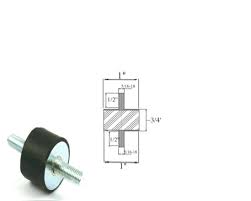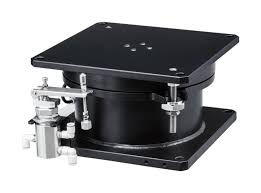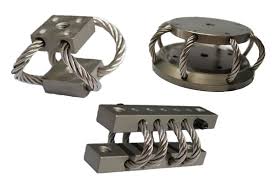Enhancing building safety with seismic isolators: A must-know guide
Seismic isolators for buildings are a crucial component for enhancing safety in earthquake-prone areas. This must-know guide will provide valuable information on how seismic isolators can be used to improve the stability and resilience of buildings during seismic events. With the increasing frequency of earthquakes worldwide, understanding the importance of seismic isolators and how they contribute to overall building safety is floor mount vibration isolators essential for architects, engineers, and building owners. This guide aims to offer a comprehensive understanding of seismic isolators and their role in ensuring the structural integrity of buildings in the face of seismic activity.
Enhancing building safety with seismic isolators involves incorporating seismic base isolation devices to reduce the impact of seismic events on structures. These isolators act as a buffer between the building and the ground, allowing for greater flexibility and reduced transfer of seismic forces. Key components of this guide include understanding the principles of seismic isolators, selecting the right type for specific building requirements, and implementing proper installation and maintenance practices. By following this guide, building owners and engineers can mitigate the potential damage caused by earthquakes and improve overall safety.
Enhancing building safety with seismic isolators is crucial to minimize the impact of earthquakes on structures. The guide provides comprehensive information on the principles and types of seismic isolators, along with guidance on their selection, installation, and maintenance. seismic isolation bearings It equips building owners and engineers with the knowledge to effectively mitigate seismic forces and enhance overall safety. The guide offers invaluable insights into incorporating seismic isolators as a key component of building safety measures.
The Importance of Seismic Isolators for Building Safety

Seismic isolators are crucial for building safety as they help to minimize the damage caused by earthquakes. These devices are typically installed between a building's foundation and structure to reduce the impact of ground motion. By allowing the building to move independently from the ground's movements, seismic isolators can significantly decrease the structural stress and potential damage during an earthquake. This technology has been proven to be effective in safeguarding buildings and their occupants, making it an essential consideration for construction in seismic-prone areas.
How Seismic Isolators Keep Buildings Secure During Earthquakes
hvac vibration isolators residential

Seismic isolators are devices that are incorporated into the foundation of buildings to help protect them during earthquakes. They work by decoupling the building from the ground motion, allowing the structure to move independently from the shaking of the ground. This helps to absorb and dissipate the seismic energy, reducing the impact on the building and its occupants. Seismic isolators come in various forms, including elastomeric bearings, sliding bearings, and hybrid systems. These devices are designed to provide flexibility and movement, which helps to minimize the transfer of seismic forces to the building. By allowing the structure to move more freely during an earthquake, seismic isolators help to reduce the risk of structural damage and potential collapse. In addition to protecting the building itself, seismic isolators also help to safeguard its occupants. By mitigating the effects of ground motion, these devices can help prevent injuries and potentially save lives during an earthquake. Overall, seismic isolators play a crucial role in keeping buildings secure and resilient in the face of seismic activity.
Types of Seismic Isolators for Different Types of Structures

Seismic isolators are devices that are used to reduce the impact of earthquakes on buildings and other structures. There are different types of seismic isolators that may be used, depending on the type of structure. Some of the most common types of seismic isolators include: 1. Elastomeric isolators: These isolators are made from layers of rubber and steel or other materials, and are often used in buildings with low to moderate seismic risk. 2. Lead-rubber bearings: These isolators consist of a lead core surrounded by rubber layers, and are commonly used in buildings and bridges with a moderate to high seismic risk. 3. Friction pendulum systems: These isolators use a sliding mechanism to dissipate seismic energy and are often used in bridges and other long-span structures. 4. Fluid viscous dampers: These isolators use the resistance of fluid to dissipate seismic energy and are often used in tall buildings and other structures with high seismic risk. Each type of seismic isolator has its own advantages and drawbacks, and the best choice for a particular structure will depend on factors such as the level of seismic risk, the size and weight of the structure, and the cost of installation.
The Role of Seismic Isolators in Retrofitting Older Buildings

Seismic isolators are essential in retrofitting older buildings to improve their resilience against earthquakes. These isolators are typically installed between the building's foundation and its superstructure to mitigate the impact of ground motions during seismic events. By absorbing and dissipating the energy generated by earthquake movements, seismic isolators help to reduce the building's overall structural response, protecting it from potential damage. This retrofitting technique has been increasingly employed to enhance the seismic performance of older structures and ensure the safety of occupants during earthquakes.
The Science Behind Seismic Isolators and Their Functionality
hvac vibration isolation
Seismic isolators are devices designed to protect structures from the damaging effects of earthquakes by reducing the transmission of ground motion to the building. They work by allowing the building to move independently from the ground motion, essentially decoupling the structure from the shaking of the ground. This is achieved through the use of bearings, sliders, or dampers that absorb and dissipate the energy from the earthquake, preventing it from reaching the building. This helps to minimize structural damage and ensures the safety of occupants during seismic events. The science behind seismic isolators involves a deep understanding of structural dynamics and earthquake engineering principles, as well as material science and mechanical engineering. Various factors such as the type of isolator, its placement, and the specific characteristics of the building and the surrounding soil all play a role in determining the effectiveness of seismic isolators in safeguarding structures against earthquakes.
Choosing the Right Seismic Isolator for Your Building Design
Choosing the right seismic isolator for your building design is essential in ensuring the safety and stability of the structure during an earthquake. Factors to consider include the building's location, type of construction, and anticipated level of seismic activity. There are various types of seismic isolators available, including elastomeric, sliding, and friction pendulum isolators, each with its own advantages and limitations. It is important to consult with a professional engineer to determine the most suitable isolator for your specific building design. Additionally, proper installation and maintenance of the isolators are crucial for their effectiveness in mitigating seismic forces.
Seismic Isolators: A Crucial Component in Modern Construction
Seismic isolators are crucial components in modern construction as they help to protect buildings and infrastructure from the destructive forces of earthquakes. These isolators are typically placed between a structure's foundation and its superstructure to reduce the transmission of ground motion to the building. This helps to minimize the potential for structural damage and collapse during seismic events. Seismic isolators come in various forms, including elastomeric bearings, sliding bearings, and fluid viscous dampers, each offering different levels of isolation and energy dissipation. By incorporating seismic isolators into building design, engineers can significantly improve the overall earthquake resilience of structures, ensuring the safety of occupants and the longevity of the built environment.
Seismic Isolators: Ensuring Resilience in High-Risk Seismic Zones
Seismic isolators are devices that are used to protect buildings and infrastructure from the damaging effects of earthquakes. They work by decoupling the structure from the ground motion, allowing the building to move independently of the shaking caused by the seismic waves. This helps to reduce the forces and displacements transmitted to the building, and can significantly decrease the likelihood of structural damage or collapse during an earthquake. Seismic isolators are typically made from materials such as rubber, steel, or lead, and are placed between the building's foundation and superstructure. They can come in various forms, including elastomeric bearings, sliding bearings, or base isolators. The choice of isolator depends on factors such as the size and type of building, the expected level of seismic activity, and the local soil conditions. Installing seismic isolators can be a cost-effective way to improve the resilience of structures in high-risk seismic zones, as they can help to mitigate the need for costly repairs or rebuilding in the event of an earthquake. They are commonly used in critical facilities such as hospitals, power plants, and emergency response centers, as well as in bridges, cultural heritage buildings, and other structures of historical significance. Overall, seismic isolators play a crucial role in ensuring the resilience of buildings and infrastructure in earthquake-prone areas, helping to protect lives and minimize the economic and social impact of seismic events.
In conclusion, seismic isolators are a crucial tool in enhancing building safety and protecting structures from the impact of earthquakes. By utilizing seismic isolators, buildings can better withstand seismic forces and ensure the safety of occupants. It is important for engineers and construction professionals to understand the importance of integrating seismic isolators into building design and construction to minimize the impact of seismic events. Seismic isolators for buildings are an essential component in safeguarding structures and saving lives.
See also
https://www.easyflex.in/vibration-isolation-products.html
Comments
Post a Comment